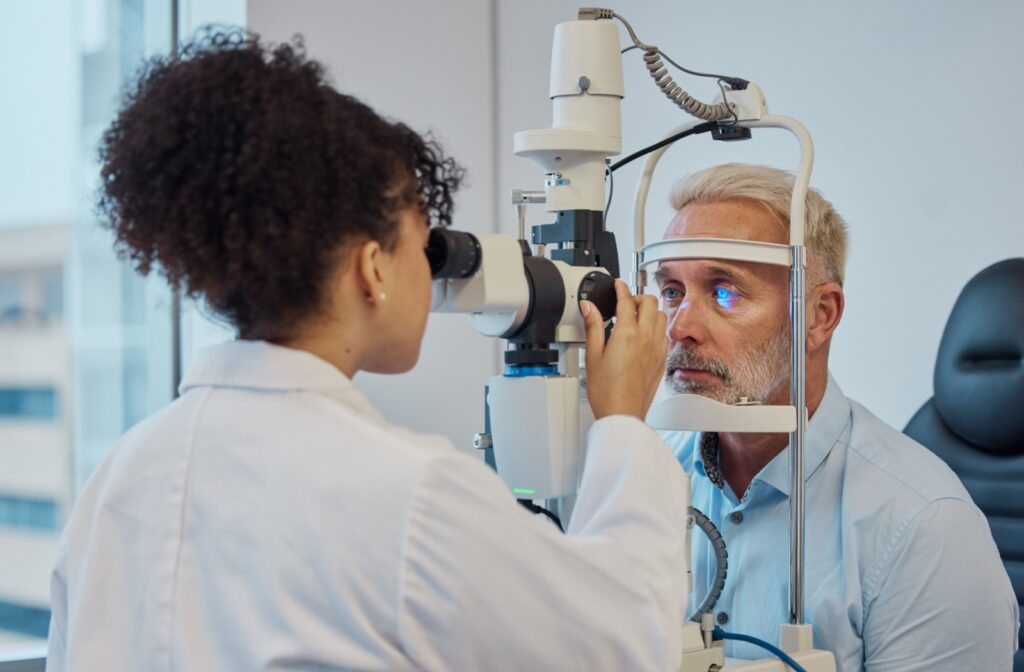Macular degeneration is a condition that affects the macula, a small yet crucial part of the retina, located at the back of the eye, responsible for detailed central vision. The macula is what allows people to read, drive, recognize faces, and see fine details clearly. When it begins to deteriorate, central vision can become blurred, distorted, or darkened, while peripheral (side) vision often remains unaffected.
There are 2 main forms of the condition: dry and wet macular degeneration. Although they share similarities, they differ in their progression and the way they affect vision. Wet macular degeneration progresses rapidly due to the leakage of blood vessels, while dry macular degeneration develops more slowly as the macula thins over time.
Having a clear understanding of each type can help patients notice potential changes in their sight and seek professional guidance early on.
What Is Dry Macular Degeneration?
Dry macular degeneration is the more common form of the condition. It develops gradually as the cells in the macula thin and break down. This slow process often means vision changes aren’t noticeable right away, but over time, it can lead to difficulty with tasks that require sharp central vision.
Some common signs of dry macular degeneration include:
- Blurred or fuzzy central vision
- Needing more light to read or work up close
- Colours appearing less rich or vibrant
- Difficulty recognizing familiar faces
Because it progresses slowly, some people may not realize they have dry macular degeneration until everyday tasks begin to feel more challenging. Regular eye exams are important for detecting the earliest signs, even before symptoms become noticeable.
What Is Wet Macular Degeneration?
Wet macular degeneration is less common but tends to progress more rapidly. It occurs when abnormal blood vessels form beneath the macula. These fragile vessels can leak fluid or blood, which damages the tissue and leads to sudden and often significant changes in central vision.
People with wet macular degeneration might notice:
- Straight lines appearing bent, crooked, or wavy
- A dark or empty spot developing in the centre of vision
- Rapid worsening of detail-oriented tasks, such as reading fine print or threading a needle
Because wet macular degeneration can significantly affect vision, early diagnosis and timely management are crucial for minimizing its impact.
Risk Factors for Macular Degeneration
While anyone can develop macular degeneration, certain factors may increase the likelihood. Knowing these risk factors can help patients take steps to protect their vision and encourage more consistent eye care. Risk factors can include:
- Being over 50, with risk increasing over time
- Family history of macular degeneration
- Smoking, which reduces healthy blood flow to the eyes
- High blood pressure or cardiovascular concerns
- Excessive sun exposure without protection
- A diet low in leafy greens, antioxidants, and omega-3 fatty acids
Although these factors don’t guarantee that someone will develop the condition, they highlight why regular monitoring and lifestyle adjustments are important for long-term eye health.

Living with Macular Degeneration
Adapting to macular degeneration can feel daunting, but many people continue to lead full, independent lives with the right tools and support. Low-vision aids such as magnifiers, brighter lighting, and specialized glasses can make daily tasks more manageable. Technology, such as screen readers or voice-activated devices, also helps people stay connected and active.
Advanced AMD Treatment Options at iSight Optometry
At iSight Optometry, we’re proud to be among the few clinics offering cutting-edge treatment options for age-related macular degeneration (AMD). For patients with dry AMD, we provide access to two innovative therapies: MacuMira, an in-office treatment, and Arunalight, a convenient at-home option.
For those diagnosed with wet AMD, we collaborate closely with experienced retinal ophthalmologists who specialize in anti-VEGF injections, ensuring our patients receive the most comprehensive care possible.
Your vision is our priority, and we’re committed to staying at the forefront of AMD management to help you protect and preserve your sight.
In addition to treatments, ongoing monitoring is key to protecting long-term vision. That’s why we include OCT (Optical Coherence Tomography) and Optomap retinal imaging for all patients with AMD — at no additional cost. Not all clinics provide this technology, but we believe early detection and consistent monitoring are essential to supporting both vision and quality of life.
The Importance of Regular Eye Exams
One of the most effective ways to address macular degeneration is through regular eye exams. Even before noticeable symptoms develop, ocular imaging can reveal subtle changes in the back of the eye. Detecting these changes early allows for timely discussions about lifestyle adjustments, treatment options, or supportive tools.
Modern diagnostic technologies make it possible to see detailed images of the macula, providing both patients and their care providers with a clearer understanding of eye health. This level of insight helps people feel informed and prepared as they make decisions about their care.
A Personalized Approach to Eye Health
Every person’s experience with macular degeneration is different, and that’s why personalized care matters. Support may include explaining imaging results, walking patients through different management options, or connecting them with resources that help them adapt to vision changes.
At iSight Optometry, our team focuses on pairing modern technology with a personal touch. Beyond diagnosing conditions like macular degeneration, we emphasize helping patients understand their eye health in a clear and approachable way. Book an appointment with iSight Optometry today to experience personalized eye care with clear, supportive guidance for your vision health.





